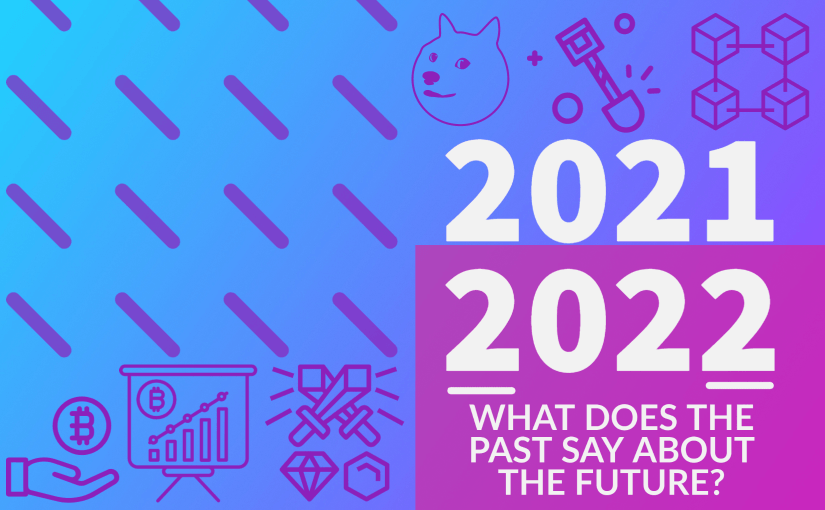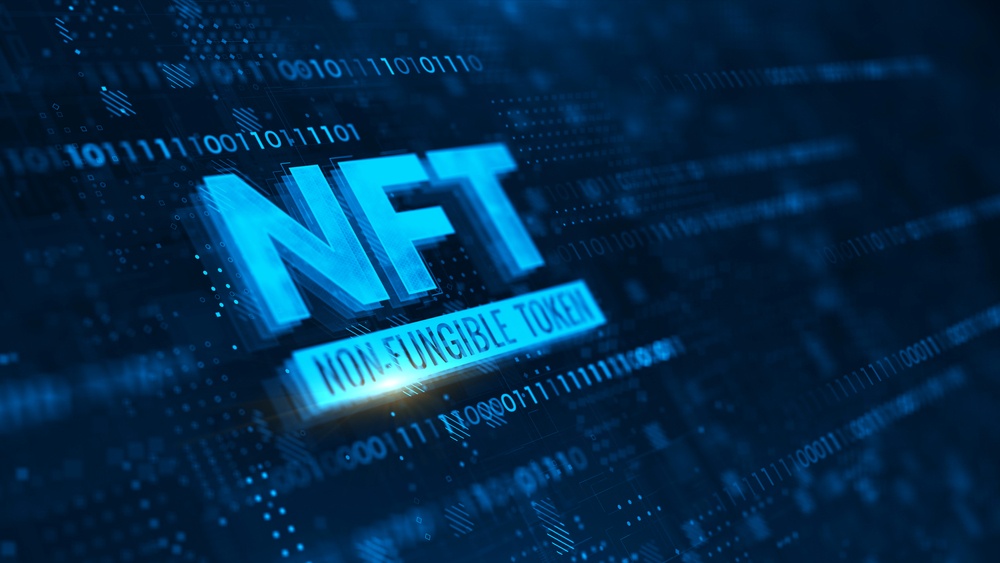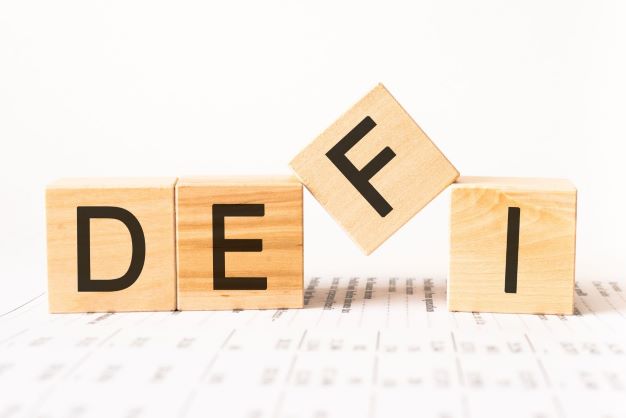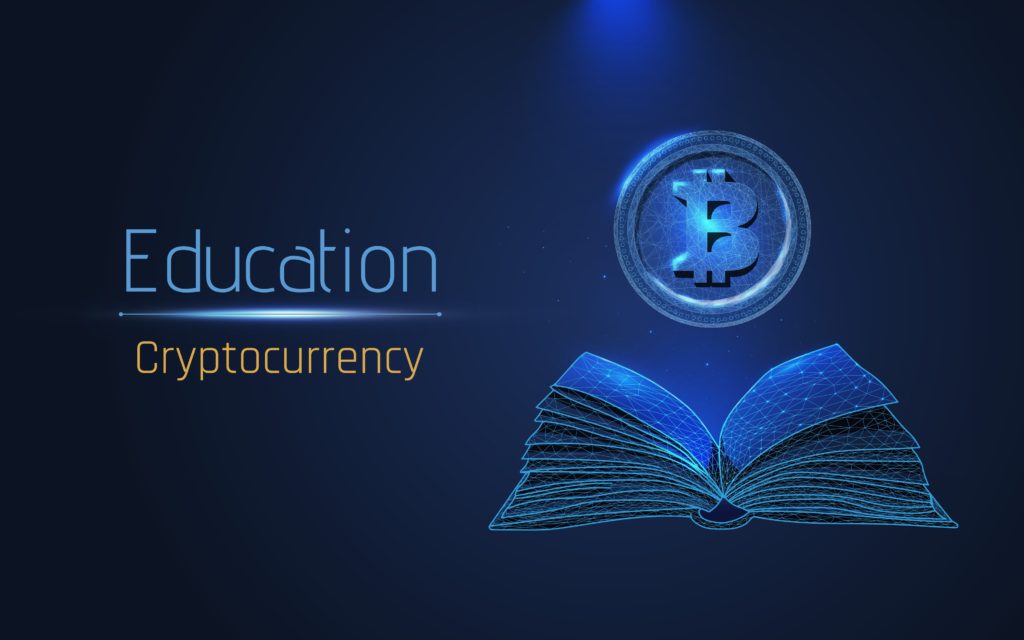Crypto Year In Review: What Does The Past Say About The Future?

As always, the last days of each year are a time for us to reminisce on the highs and lows of the crypto industry if there are any. Although 2021 has been a roller coaster year for the crypto industry in general, the last 12 months have been an eye-opener to the immense possibilities of Web 3.0. For one, the explosive adoption of NFT has given new meanings to digital ownership and tokenization. Also, DeFi has continued to grow at a blistering pace with new functionalities and applications being introduced to improve on the progress achieved in 2020. On the downside, crypto regulation remains as murky as ever due to the uncertainties revolving around the legality of stablecoins.
Understandably, it is not far-fetched to assume that the prevailing trends of 2021 will set the tone for the coming year. And so, as we look back at the exploits of the crypto scape in 2021, it is also necessary to discuss how they might impact the industry in 2022. Here, I will do a recap of 2021 and predict some of the trends that will take center stage in 2022.
Year In Review: The Good
Non-Fungible Tokens

In 2021, Non-fungibility became a trendy attribute even as more physical assets continue to find their way to the digital realm. Before we break down the NFT craze that very much dominated other prominent talking points this year, it is important to point out that NFT is not necessarily a new concept. Those familiar with the basics of the crypto industry know that the concept of NFT has been around for over 8 years. However, it was not until Ethereum introduced the ERC-721 token standard in 2017 that it became widely adopted as a viable variant of digital assets.
Simply put, non-fungible tokens enable the system to establish rarity and ownership in the digital world. And while there have been several developers that have capitalized on this technology, we witnessed the first wave of NFT’s mainstream adoption in 2021, thanks to the explosion of digital artworks tokenized on the blockchain. Notably, NFT-based digital art remains a prevailing theme all through 2021.
All-in-all, NFT introduced the possibility of preserving the value of digital items. So, I for one have always expected it to become a massive sector on its own, what I did not expect, however, is the extent to which it has penetrated mainstream consciousness. Notably, a critical turning point in the NFT movement came early this year (specifically, 11th March) when Beeple sold a collage of 5,000 of his artworks for over $60 million. Historians will look back at this day and highlight the cultural impact it had on the art world as well as the mainstream media.
If you are an avid follower of mainstream media platforms, you will notice that at some point they had no other choice but to go with the flow. In some cases, these platforms even went all out to launch NFTs of their own. At the moment, the level of FOMO trailing the NFT craze is at an all-time high such that the inclusion of the word “NFT” in any project is bound to attract investors and critics alike.
While NFT has had a very impressive year, the journey has been far from smooth sailing. I will highlight some of the major talking points regarding the drawbacks of NFT water in this guide.
Decentralized Finance 2.0

DeFi achieved global recognition in 2020 just around the period the first wave of lockdowns commenced. At the beginning of this movement, the goal was to create a self-sustaining economy where participants had full control over their finances. This coupled with the promise of high yields compared to what we have in traditional finance sparked the hype that saw DeFi tokens outperform established cryptocurrency for long periods in 2020.
At the height of this frenzy, analysts began to highlight the burble nature of the DeFi market. On the one hand, some argue that the emerging sector was a disaster waiting to happen. On the other hand, proponents acknowledged the existence of unviable market trends but argued that they would eventually give way to more sustainable systems. More than a year down the line, it is clear that the more optimistic argument has won the day. Unlike what we experienced in 2020, DeFi has had a more grounded and yet productive outlook whereby developers and users alike are more focused on expanding the scope of DeFi.
However, the primary goal for many developers remains the same: Bringing in more users and attracting more capital. And to achieve this, they know that the promise of high yields is no more enough. Today, DeFi developers and entrepreneurs must also elevate user experience to make it easier to access and use DeFi protocols. Note that the first set of DeFi users were understandably individuals who were not big fans of traditional finance. Ultimately, the next phase of growth will require protocols to appeal to the more mainstream audience. And this is only possible when the infrastructure powering these protocols bears some semblance with conventional financial platforms.
As such, it comes as no surprise that several protocols have begun to integrate infrastructures that allow users to move in and out of the DeFi ecosystem seamlessly. Another thing that I have noticed is the introduction of other DeFi-based blockchains, including Solana, Binance Smart Chain, and others. The influx of these options has to an extent eliminated the challenges peculiar to the Ethereum ecosystem, which has historically been prone to network congestion and high fees. Due to the combination of these factors, the DeFi sector now boasts over $250 million worth of capital, up from around $20 million at the beginning of 2020.
Bitcoin As Legal Tender

The establishment of bitcoin as legal tender in El Salvador came at a time when bitcoin’s store of value function was more in vogue than its payment feature. For the first time, a country has acknowledged the capability of bitcoin to function as an alternative to fiat and has put the infrastructure in place to allow its citizens to adopt the digital currency. However, it remains to be seen whether bitcoin will succeed as a legal tender knowing fully well that it is prone to volatility.
Year In Review: The Bad
Crypto Education

Even with all the achievements highlighted above, it is still clear that crypto education is still not at the level we had hoped for. Crypto illiteracy is still one of the factors limiting crypto growth because the technology is still a mystery to the average Joe. And for the first time, we can no more blame this on the unavailability of crypto education materials. One thing I have noticed is that not many people out there want to go out of their way to learn new things, especially one that could alter the way we view money.
For instance, the lack of crypto education usually emerges as the limiting factor to the success of crypto projects. In some cases, even governments are known to feign ignorance in an attempt to stifle the adoption of cryptocurrency. For example, Nigeria’s government claims that its hostile stance against cryptocurrencies, particularly the decentralized ones, boils down to the perceived secrecy of their operations. According to some of the statements released by officials of the country’s apex bank, bitcoin and similar cryptocurrencies are mostly used by illicit individuals to cloak their activities. Those familiar with the workings of digital assets would know that this is not entirely true. So, to base the decision to ban crypto on such an assumption is a clear reflection of the crypto literacy level of regulators in Nigeria.
Speaking of the effects of crypto illiteracy, it is worth pointing out that Book Twitter, a once-promising literary NFT project came falling like a house of cards because of misinformation. You can read about how this project came to an end before it even began here.
In another event that showcases the torrid state of crypto education, Ubisoft’s planned NFT integration has been met with criticism. Even though the gaming giant has opted for a proof-of-stake blockchain considered to be more environmentally friendly and cost-effective, misinformation abounds that Ubisoft’s offering will have a damning effect on our environment.
Crypto Regulations Are Still Murky

Each year, regulation has always been a major talking point in the crypto industry. And as expected, it was also a recurring theme in 2021. Regulators around the world are still trying to figure out the right way to approach cryptocurrency. In particular, regulators have suddenly awakened to the risks associated with stablecoins. This is why stablecoins have increasingly come under regulatory scrutiny with many regulators looking to ensure that users are adequately shielded from risks. More importantly, they are motivated to ascertain that private-owned stablecoins do not overshadow their attempt at creating central bank-backed digital assets.
Regardless of the factors fueling a country’s pursuit to regulate cryptocurrency, the fact remains that they hardly collaborate. Hence, crypto regulation across the globe is all over the place. There are hardly any global standards nor are there coordinated attempts to create unified regulations. In essence, it is always difficult for crypto companies to keep up with the ever-changing crypto landscape, especially when running a globalized operation.
Also, we cannot discuss regulation without touching on China’s decision to ban crypto outrightly. Although it did not come as a shock, since China has never been a fan of bitcoin, the timing and the length China was ready to go was enough to send ripples across the crypto market. More specifically, the impact it had on the bitcoin mining economy was historical. Not only did the total hash rate drop to an all-time low, but it also forced China-based miners to either close up shop or migrate to the crypto-friendly nations.
Environmental Impact

It is no more news that Ethereum-based NFTs are expensive to mint and trade. This is because the network relies on the proof-of-work consensus mechanism, which is computer-intensive. And since the majority of NFT-based activities and items are based on the Ethereum network, concerns have been raised about the environmental impact of NFTs so much so that certain projects have been abandoned in light of their energy-intensive effects of NFTs.
However, as mentioned earlier, more alternative blockchain networks with less computer-intensive consensus mechanisms went live in 2021. This allows users and companies to interact with the NFT market and still ensure that their operations are not harming our environment. Nonetheless, most analysts believe that the environmental deficiency of NFTs will be put to rest only when Ethereum successfully transitions from the proof-of-work system to the proof-of-stake model. Fortunately, this process has kicked off with Ethereum 2.0 launching late last year. However, this is an unprecedented development and so it would take some time for things to fall into place.
Now that we have listed the good and the bad, it is time to explore the things that 2022 has in store for the crypto industry.
Crypto 2022: What Are The Things To Expect?
More NFT Applications

It is important to note that NFTs are majorly statement pieces for the wealthy. The prestige of owning an NFT-based avatar and proudly flaunting them on Twitter has become the major propellant for some of the most expensive NFT sales. As Liam Bussell, head of corporate communications and investor relations at Banxa, a fiat-crypto gateway, puts it, it is not hard to feel some kind of way about the overly lavish state of the NFT market:
“Someone who’s bleeding money can buy a link for millions, but that’s because they might as well burn their money for fun, and they want to show off their wealth to the world. Good luck charging a Regular Joe $150,000 for a link to a picture, though. The focus on NFTs as art by definition limits a promising technology to a relatively small, albeit inarguably posh and eccentric, niche. The good thing here is that the big NFT digital art sales are making headlines, which is helping to bring NFTs into the mainstream. However, this will not be the main use of NFTs further down the road, but rather a new and expensive plaything for the wealthy and some especially fervent crypto-personalities and communities.”
That said, Bussell added that NFTs will take up less flamboyant use cases that will appeal not only to the wealthy but also to the average Joe. According to him, the fact that NFTs are slowly finding their ways into the mainstream gaming world shows that there is much more that can be achieved in the coming years:
“The fields where NFTs will likely take off in a big way, if not become the new default way of doing things, aren’t as sexy as high-end luxury. They will, however, greatly benefit from the key feature that NFTs bring to the table: The ability to confirm the authenticity of the associated digital asset. This could be, for example, as simple as the hash of a financial document saved as an NFT on a private or a public blockchain to check whether it’s been tampered with later on. Software licensing and authentication seems like one of the areas where NFTs will shine, given enough time, with the bonus of possible interoperability. Corporations and individuals alike could shop for licensed software pieces on a single platform, leasing it for as long as needed. This would cut the costs, while also keeping chief information officers’ peace of mind as they have an extra layer of security knowing that any digital asset can be safely and quickly authenticated.”
In a similar vein, Ben Arnon, co-founder and chief revenue officer at Curio, argued that moving forward NFT developers should focus on creating more value for consumers:
“The future of NFTs becomes increasingly potent as we in the industry continue to think first and foremost about fans and consumers. We must shift the attention of the media and consumers away from the six and seven-figure primary sales numbers to a focus on creating real value by way of infusing true utility into NFTs. We must focus on creating smart, strategic collections of NFTs (as opposed to one-off drops) that gain enhanced value over time as the utility of the NFTs purchased becomes increasingly evident to fans.”
DeFi To Unlock New Opportunities

One thing I have noticed about the DeFi market is the fast pace at which innovative solutions are being introduced. The sector has experienced unprecedented growth in the last 12 months. And from all indications, this will likely continue into the new year. This is because developers are yet to scratch the surface when it comes to disrupting the trillion-dollar traditional finance (TradFi) sector.
While highlighting the disparity between TradFi and DeF, Artem Tolkachev, founder and CEO of BondAppetit, explained that there is a massive growth opportunity for DeFi:
“Ethereum network processes over 1.3 million transactions each day in 2021, encompassing remittance, trading, lending, borrowing and various other types of transactions. This is a tiny number as compared to over 1 billion daily global credit card transactions, and the around 5.5 billion daily trading volume in NASDAQ. Capturing 1% of the credit card transactions on the Ethereum chain is at least 8x-ing its current volume.”
Also, Tolkachev highlighted that the global crackdown of crypto has not slowed down the DeFi movement even as just a mere fraction of global crypto users are actively engaged in the DeFi market. However, he added that the next phase of growth depends on the capability of developers to improve UI/UX of existing and new DeFi protocols:
“Even though countries like China continue to crack down on crypto, it will only accelerate the use of DeFi. Active Ethereum wallet and browser extension MetaMask users have 10x-ed to 10 million in August 2021. While this is a seemingly high number, it represents only a 5% penetration rate amongst the 221 million global crypto users. This shows that the general crypto users, who are used to frictionless centralized services such as Robinhood, are a massive untapped market for DeFi and can be captured as the UI/UX is improved.”
More Crypto Regulations

There is every reason to believe that regulators will continue to propose new regulatory frameworks designed to tame the wild west nature of the crypto industry. More specifically, I believe that the intense debate concerning stablecoins will begin to culminate in policies that will eventually govern the operations of privately-owned digital assets. Although most believe that the introduction of regulation could water down the whole essence of using cryptocurrency in the first place, it is important to note that crypto will only go mainstream if there are policies put in place to curtail illicit activities. Bob Reid, CEO and co-founder of Everest, recently made a similar argument while proposing the ways regulators can go about regulating stablecoins. He wrote:
“Of course, some might say that regulation will only slow down innovation, so governments should stay out of the crypto lane, but this argument is missing historical context. Way earlier, in the wildcat banking era, private currencies issued by rogue banks would often leave people buying in with worthless papers, so the greenback was enshrined as the only national currency of the United States. The same logic applies to the 2008 money market fund crisis when the federal authorities put new rules in place to protect the Regular Joe from big-time investors pulling in large sums from those.”
Another sector that would likely come under intense regulatory scrutiny is NFT seeing that it is fast becoming a recurring theme in mainstream industries. I expect that regulators will begin to look into the workings of the sector and will eventually attempt to establish frameworks to govern the activities of participants. Will Gottsegen of Coindesk emphasized the importance of NFT regulation following the recent insider-trading scandal at OpenSea that forced one of its top employees to resign. He wrote:
“An NFT is very clearly an asset with a resale value that rises and falls. It can be many things – an artwork, a fundraising vehicle, a digital VIP pass – but more often than not, it’s something you can resell. Whatever an NFT is, it’s also a trading card. To buy one is to buy into the crypto market, which is to engage with those whiplash ups and downs. The inherently speculative aspect of crypto is something that tends to get lost in the rhetoric surrounding digital assets. NFTs and decentralized applications built on Ethereum are always going to involve an element of risk. It’s something that’s built into the technology itself – the double-edged sword of blockchain tech, a blessing and a curse. And as long as investments go up and down, there will be insiders trying to get ahead. The Securities and Exchange Commission requires publicly traded companies to disclose executives’ stock trades for exactly this reason.”
CBDCs Will Lose Their Potency

As more countries continue to unveil CBDCs, there will come a time when it will become apparent that highly censored forms of digital cash are far from appealing to the general public. However, this does not necessarily mean that central banks will lose the control they currently wield over their respective economy. J.P. Koning, a Coindesk columnist, in an article where he listed how he expects money to evolve, stated that CBDCs, as well as cash, will fade into oblivion:
“A few major Western central banks will try CBDC, but they’ll find citizens don’t have an appetite for a KYC’ed electronic version of the dollar or euro – their existing bank or fintech fill most of their needs, thank you very much. Seeing how tepid the demand is for CBDC, other central banks watching from the sidelines will retire their CBDC aspirations. With their dreams of CBDC dashed, central banks’ lone connection to regular people will be old-fashioned banknotes. But usage of physical banknotes in commerce will continue to decline, too, with ATMs getting as rare as phone booths. By the late 2020s, what was once a standard service offered by all bank branches – cashing out a bank balance into paper money – will be a fairly exotic transaction. If millennials don’t know how to write a check in 2011, Generation X won’t know how to use cash in 2031. Central banks fear this moment. They’ve always liked being at the front and center of the payments system. But they have nothing to worry about. We rarely think about the sewer system. We don’t interact directly with water mains or care how treatment plants work. But ultimately our entire lives depend on these unsexy bits of infrastructure.”
Decentralized Automated Organizations (DAOs)

Another good thing that came out of the DeFi movement is the growing adoption of a decentralized governance system. In most cases, DeFi protocols opt for an intermediate-free model where users are offered the chance to become stakeholders. They get to vote on issues relating to the development and day-to-day running on the protocol. While a DAO has become an important component of every decentralized application, they are fast becoming a theme in the crowdfunding space, with many showing interest in joining decentralized networks of investors focused on raising capital and jointly owning a business or venture.
Michael O’Rourke, the co-founder and CEO of Pocket Network, explained the importance of DAOs in an article published on Cointelegraph. In the article, he wrote:
“A DAO is essentially a programmable organization of people that form around a shared mission and fosters an emergent online community. They jointly control a crypto multi-signature wallet, ensuring that its objectives — decided by DAO members — are met. The governance of DAOs and their operations are written in smart contracts, consisting of automated if-then statements, making them transparent and auditable.”
O’Rourke added that DAOs promote a collaborative and open community ideal for powering projects:
“What’s great about DAOs and their role in online communities is that the way they interact with each other is a wide-open surface area and there is much work being done in the space. Anyone can take part in a DAO regardless of where they are. All that’s required is the staking of funds, which creates a great building block for interacting with a community. DAOs are not walled gardens and therefore their participants have intrinsic and extrinsic incentives to collaborate with other DAO communities to bolster each other’s capabilities while sharing in the ownership and direction of each project. With no central party standing in the way, everyone is given a right to have a say about how something is or should be done.”
Armed with this tool, inventors and crypto enthusiasts have begun to create and join communities that align with their goals. From all indications, it is clear that this trend will continue to evolve in the coming year.
Metaverses

The digital world has begun to take shape thanks to the emergence of NFTs. Now, companies are looking to develop virtual platforms where users can enjoy all of the benefits of a limitless digital realm. This is even more worthwhile if users can outrightly own the items featured in metaverses. And so, metaverses are viewed as the future of social networks, blockchain gaming, and whatever you could think of, which is why tech companies are going all out to establish themselves on this front.
A notable pointer of the metaverse frenzy is Facebook’s sudden rebranding to Meta in what seems to be an attempt to make known its intention to dominate the metaverse discussion. However, for all the buzz surrounding the emergence of metaverses, there is still a lot we are yet to understand about this technology. On the one hand, it is not yet clear whether a decentralized or centralized governance model will best suit a metaverse. There are also concerns raised about regulations and how they will impact the viability of digital worlds anchored by VR/AR, NFTs, and maybe blockchains. For what it is worth, the metaverse is one of the new trends introduced in 2021 and we cannot wait to see how it comes to life in 2022.
Seeing that all of the projected crypto trends of 2022 require Web 3.0 technology, it is safe to say that it is the year at which Web 3.0 showed its full potential. So to cap off all the positives of 2021, here is a breakdown of Web 3.0 and how it has impacted proceedings in the ongoing crypto evolution.
2022: The Year Of Web 3.0

Web 3.0 promises an open ecosystem where each participant functions as the custodian of their data and assets. In essence, the goal is to enable infrastructures that do away with the over-centralized system of web 2.0. While highlighting the core traits of Web 3.0, Doug Petkanics, co-founder at Livepeer, stated that Web 3.0 offer an open and transparent economy anchored by decentralized applications as against the current model of the internet majorly influenced by Big Tech companies like Google, Amazon, and so on:
“The open-source nature of Web 3.0 means that rather than proprietary code being hacked and leaked, contributors can collaborate on technology and features from day one. Contrast that with the walled gardens built and protected by the Big Tech gatekeepers. Once locked inside, there’s little recourse or ability to leave. People, companies and developers are simply beholden to the whims of the centralized authority, forced to adapt to changes in product or terms.”
Petkanics explained further that the transparency and openness of Web 3.0 provide creators and developers the freedom to explore a wide variety of possibilities:
“At its most pure, the Web 3.0 economy is transparent and permissionless, giving stakeholders the confidence that entrenched interests aren’t secretly pulling the strings and controlling outcomes in their favor. This form of creative patronage becomes more popular every day, as it’s much more creator-friendly than current options… These transparent economics are what creators lack from existing Web 2.0 dynamics. As creators build within walled gardens, they remain locked into whatever economics each platform chooses. And if the platform changes those economics, the creator has little recourse: With few alternatives, the option to leave is often economically infeasible.”
Lastly, Web 3.0 establishes an incentive-based economy designed to evenly distribute revenue among protocols, users, and content creators. As highlighted by Petkanics, this is unlike what we have in web 2.0:
“Accountability and governance are major issues when it comes to aligning incentives. Web 2.0 gatekeepers have little incentive to “do right by” creators and users. Why would they? Since there’s little competition, users are stuck in the walled garden. And, as privately-owned entities with little outside regulation, they can do whatever they want. It’s a “we set the rules, so take it or leave it” attitude and an “us vs them” mentality.”
According to Petkanics, Web 3.0 establishes user and creator-focused platforms by implementing DAOs and ensuring that participants are carried along when it comes to governance:
“With Web 3.0, governance is often decentralized via a decentralized autonomous organization, or DAO, or other ingrained community feedback mechanisms. By decentralizing community management away from centralized authorities, there’s a tendency toward self-moderation. Communities built around shared passions enjoy natural moderation and when community members step out of line, the community takes action. And if a community member dislikes something, they can submit proposals for community vote to change the platform’s direction.”
To achieve this, tokens are usually issued to ensure that voting rights and rewards are openly and fairly distributed among users:
“Ultimately, creators want more direct relationships with their fans and influence over the governance of the platforms they use. The Web 3.0 paradigm attempts to address this by enabling creator-driven platforms that also allow users to be owners in platforms, often coordinated through tokens. As they benefit directly through the growth of the platforms, users have the incentive to provide key services like moderation to prevent things like hate raids.”
